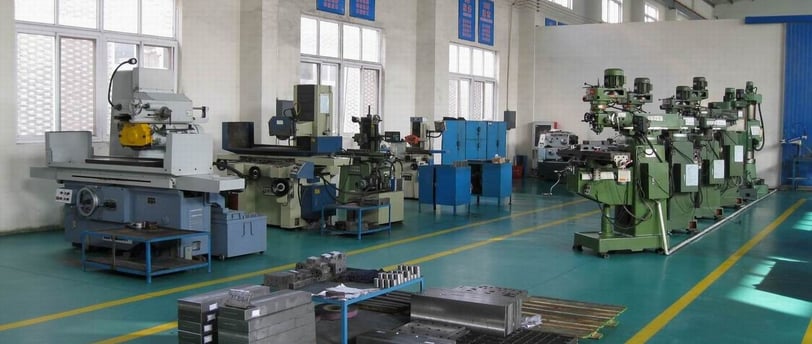Innovative Design of Stamping Tooling Based on Digital Technology
2/15/2025


Introduction to Stamping Tooling
Stamping tooling refers to the production equipment and tools utilized in the stamping process, which involves the shaping and forming of materials, typically metals, through the application of pressure. This process is integral to various manufacturing sectors, including automotive, aerospace, electronics, and consumer goods. The efficiency and quality of the stamping operation largely depend on the design and functionality of the tooling used. Traditional stamping tools include dies, molds, and punches, which are meticulously crafted to produce specific shapes and dimensions required for the final product.
There are several types of stamping tools, each tailored to meet different production needs. Progressive dies, for instance, enable the fabrication of complex shapes in a continuous fashion, while transfer dies are best suited for moving parts through multiple stations in a single press cycle. Deep-drawing dies are utilized for creating hollow shapes by drawing material into a cavity, and compound dies combine multiple operations into a single stroke. Each type of stamping tool serves distinct purposes, yet they all share a fundamental goal: to optimize production capabilities while ensuring precision and repeatability in the output.
Historically, the process of designing stamping tools has relied heavily on manual techniques, often resulting in prolonged development times and limited customization options. As industries evolved and demands for higher quality products increased, there emerged a pressing need for innovation within the stamping tooling sector. The advent of digital technology is now transforming traditional design methods, introducing advanced software and tools that facilitate rapid prototyping, simulation, and customization. By leveraging these technologies, manufacturers can enhance their tooling designs, significantly improving both efficiency and precision while meeting the specific requirements of modern production environments. This progressive transition marks a pivotal moment in stamping tooling, promising to reshape the entire landscape of manufacturing processes.
Digital Technologies Transforming Stamping Tooling Design
The evolution of stamping tooling design has been significantly influenced by various digital technologies. Among these, Computer-Aided Design (CAD) stands out as a pivotal tool that facilitates engineers and designers in creating precise tool geometries and layouts. With CAD, the design process is expedited, allowing for rapid prototyping and extensive customization. The inherent ability of CAD programs to generate detailed 2D and 3D representations of designs enables improved visualization, which helps identify potential design flaws before they manifest in the physical tooling.
On the other hand, Computer-Aided Manufacturing (CAM) complements CAD by linking the design process directly to manufacturing operations. CAM software translates CAD models into machine instructions, ensuring a seamless transition from design to production. This integration not only increases production efficiency but also enhances the accuracy of machining processes. Consequently, manufacturers can produce more complex and intricate tooling that meets specific requirements with reduced lead times.
3D modeling plays a crucial role in modern stamping tooling design, providing dynamic representations of parts and assemblies. Technologies such as parametric modeling allow for quick modifications, which is beneficial when responding to changing specifications or customer demands. Furthermore, simulation techniques enable designers to forecast the performance of stamping tools under various operational conditions. By conducting virtual tests, potential issues can be identified early in the design process, thus preventing costly errors in actual production runs.
Real-world applications of these digital technologies abound in the stamping tooling industry. For instance, automotive manufacturers successfully employ CAD/CAM integration to optimize their production lines. A notable case study involved a leading automotive company that reduced its tooling design cycle by 30% through effective use of simulation and modeling strategies. The adoption of digital technologies not only streamlines the design process but also contributes to enhanced accuracy and consistency in production, thus revolutionizing the stamping tooling landscape.
Benefits of Innovative Design Approaches
The adoption of innovative design approaches in stamping tooling, particularly through the utilization of digital technology, presents numerous advantages that significantly enhance manufacturing efficiency. One of the paramount benefits is enhanced design flexibility. Digital design tools allow engineers to experiment with a multitude of configurations and modifications swiftly, enabling them to tailor tooling solutions that meet specific production requirements. This flexibility encourages creativity and innovation, resulting in optimized tooling that can adapt to various materials and shapes.
Furthermore, the implementation of these innovative approaches leads to reduced lead times. By leveraging advanced software solutions for modeling and simulation, manufacturers can identify potential design flaws early in the process. This proactive approach diminishes the time spent on revisions, allowing for faster delivery of tooling to the production line. Consequently, shorter lead times not only improve operational efficiency but also enable companies to respond swiftly to market demands.
Cost-effectiveness emerges as another critical advantage, as digital technology facilitates a more efficient use of resources. Through techniques such as digital prototyping and additive manufacturing, complex tooling designs that were previously deemed unviable are now achievable. This advancement reduces material waste and minimizes the need for excessive manual labor, yielding considerable cost savings in the manufacturing process.
Moreover, the increase in productivity is a direct outcome of these innovative practices. As manufacturers capitalize on the streamlined processes afforded by digital technology, they can significantly ramp up their output levels. Industry experts emphasize that embracing these design innovations not only enhances company performance but also fortifies competitive advantage in the marketplace. Concurrently, testimonials from manufacturers highlight how these advancements have led to notable improvements in customer satisfaction and product quality, capturing the essence of modern manufacturing excellence.
Future Trends in Stamping Tooling Design
The future of stamping tooling design is poised for significant transformation, largely driven by advancements in digital technology. One of the most notable trends is the integration of artificial intelligence (AI) and machine learning into the design process. These technologies enable the development of smart tooling systems that can analyze vast amounts of data, thereby facilitating more efficient and effective designs tailored to specific manufacturing needs. By employing predictive analytics, manufacturers can foresee potential production challenges and address them proactively, enhancing the overall reliability of the tooling.
Moreover, the Internet of Things (IoT) plays a crucial role in shaping the future landscape of stamping tooling. IoT-enabled devices can collect real-time data from machines, offering insights into performance and helping operators make informed, data-driven decisions. This connectivity not only streamlines operations but also allows for improved maintenance schedules, reducing downtime and enhancing productivity in the stamping processes. Consequently, the convergence of these technologies is driving unprecedented levels of automation in tooling design, making it more adaptable and responsive to the demands of the market.
However, this technological evolution is not without its challenges. Integrating advanced systems may present operational hurdles, particularly for companies that rely heavily on traditional methods. There is also the pressing concern of data security, as the increased connectivity can expose manufacturing systems to cyber threats. Additionally, workforce adaptation is essential; as automated systems become integral to stamping operations, workers will need to acquire new skills to manage and operate these innovative tools effectively.
In summary, the future trends in stamping tooling design underscore the importance of embracing digital technology. Staying ahead of these advancements will be paramount for manufacturers seeking to innovate and maintain competitiveness in an ever-evolving landscape. The potential for growth and improvement in this sector is immense, making it critical for industry players to invest in both technology and workforce development.
